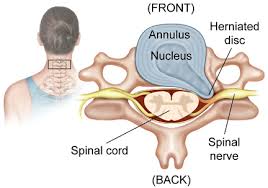A cervical disc herniation can be extremely painful and often debilitating. Unfortunately we have seen many of these cases in our clinic that have resulted from both acute traumatic and chronic long-term causes. In today’s blog we will examine the cervical disc herniation, spinal anatomy, typical signs and general treatment options which are available for sufferers.
Anatomy Of The Spine
The human spine consists of three distinct sections which are divided into the cervical, thoracic and lumbar spines. While disc herniations may occur at any level of the spine, today we will specifically look at the cervical disc herniation as it is an extremely common clinical presentation. The spine consists of individual vertebrae which are aligned on top of each other. Separating each vertebrae is the intervertebral disc which provides a ‘cushioning’ effect for the spine and promotes flexibility. A major consequence of this flexibility is the ability to undergo damage. Common disc injuries includes bulges and herniation of the inner disc material which ultimately may lead to pain and discomfort. Although rare, a disc may also sequestrate which is more serious than herniation.
What Does The Intervertebral Disc Contain?
Each disc is made of a tough outer layer which is referred to as the ‘annulus fibrosus’ and a gel-like middle called the ‘nucleus pulposus.’ A simple way to imagine this is to picture a jam donut. As our bodies age, these discs wear out and degenerate. Effectively losing their elasticity and ability to withstand injury. When a cervical disc herniates it may put direct pressure on nearby spinal nerves and cause pain, numbness, tingling or weakness in the shoulders or arms. A clinical examination for this type of problem typically involves assessing your spinal movement, reflexes, sensation and upper limb strength.
Diagnosis
While a clinical examination typically indicates the presence of a cervical disc herniation it is important to obtain further imaging. This ensures accuracy and enables your practitioner to formulate a comprehensive approach. Usual imaging includes MRI. Chiropractors work with your family general practitioner to assist with this promptly.
Signs & Symptoms
A herniated disc that is located in the neck can cause a variety of symptoms. Specific pain patterns and dysfunction depend on the exact location of the complaint. Below we have outlined the most common locations for cervical disc herniation and the typical clinical presentation.
- C4/5: presents with shoulder pain and potential deltoid weakness. Tingling or numbness may also be noticed
- C5/6: presents with shoulder and arm pain, potential biceps and forearm weakness. Tingling or numbness may also be noticed
- C6/7: presents with arm and hand pain, potential hand/wrist/finger weakness. Tingling or numbness may also be noticed
Cervical Disc Herniation Treatment Options
The treatment approach that is recommended to you is largely dependent upon the severity of the problem. Typical management may involve one or multiple of:
- Conservative Chiropractic/Physiotherapy/Osteopathy management which focuses on improving spinal biomechanics and reducing disc compression
- Medication to assist with immediate pain reduction
- Cortisone injection to reduce inflammation and effective numb pain
- Surgical intervention to replace the disc or fuse the spine
Additional information regarding disc problems can be found by clicking here.


Recent Comments